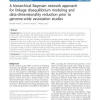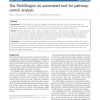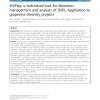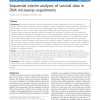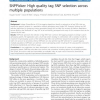BMCBI
2011
13 years 3 months ago
2011
Background: Discovering the genetic basis of common genetic diseases in the human genome represents a public health issue. However, the dimensionality of the genetic data (up to 1...
BMCBI
2011
13 years 3 months ago
2011
Background: Next-generation sequencing (NGS) offers a unique opportunity for high-throughput genomics and has potential to replace Sanger sequencing in many fields, including de-n...
BMCBI
2011
13 years 6 months ago
2011
Background: Automated, image based high-content screening is a fundamental tool for discovery in biological science. Modern robotic fluorescence microscopes are able to capture th...
BMCBI
2011
13 years 6 months ago
2011
Background: The PathOlogist is a new tool designed to transform large sets of gene expression data into quantitative descriptors of pathway-level behavior. The tool aims to provid...
BMCBI
2011
13 years 6 months ago
2011
Background: High-throughput re-sequencing, new genotyping technologies and the availability of reference genomes allow the extensive characterization of Single Nucleotide Polymorp...
BMCBI
2011
13 years 6 months ago
2011
Background: Standard graphs, where each edge links two nodes, have been extensively used to represent the connectivity of metabolic networks. It is based on this representation th...
BMCBI
2011
13 years 6 months ago
2011
Background: Discovery of biomarkers that are correlated with therapy response and thus with survival is an important goal of medical research on severe diseases, e.g. cancer. Freq...
BMCBI
2011
13 years 6 months ago
2011
Background: Linkage Disequilibrium (LD) bin-tagging algorithms identify a reduced set of tag SNPs that can capture the genetic variation in a population without genotyping every s...
BMCBI
2011
13 years 6 months ago
2011
Background: The Monte Carlo simulation of sequence evolution is routinely used to assess the performance of phylogenetic inference methods and sequence alignment algorithms. Progr...
